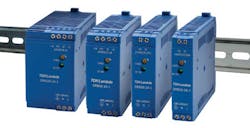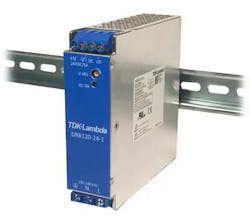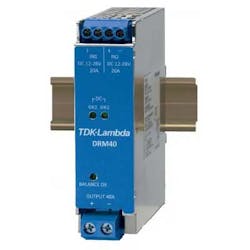How to Use Parallel Power Supplies to Improve Output and Reliability
Decreased system reliability due to overloaded power supplies is a common engineering challenge. In this Q&A-style article submitted by Allied Electronic & Automation, David Norton, technical marketing expert with TDK-Lambda, answers questions on the best ways to configuring parallel power supplies.
What are parallel power supplies, what do they do and why are they important?
Parallel power supply topologies have two or more power supplies configured to provide output power to the same system. These configurations can provide systems with more power (a higher total output current) than a single power supply, provide a redundant power supply to enhance system reliability, and mitigate excess heat generation to ease thermal management requirements and further improve system reliability.
For example, if the system load changes and requires more current than the existing power supply can provide, the system engineer can either install another power supply that can deliver more current or install two or more of the existing ones in parallel. A power supply rated for higher output power is likely to be larger than the original, though, and could potentially be taller or deeper than the cabinet can easily accommodate. So, the parallel power supply solution offers key form and fit benefits. Another benefit to parallel power supplies is that they will all have the same part number, which will be identical to the one in the existing bill of materials (BOM) and, as such, can help ease inventory management.
Like all electronic components, power supplies have a defined operational lifespan, after which they are liable to operate outside of their rated parameters, or even to fail. In a critical manufacturing process, a power supply failure could shut down an entire production line, resulting in unscheduled downtime and revenue loss. To avoid this possibility as end-of-life nears, system engineers can instead install two power supplies connected in parallel for redundancy, or an equal sharing of the load.
This configuration will enable the production line to continue operating even if one of the two power supplies fails, which will allow the manufacturer to select a suitable time to service the machine rather than forcing them to react to a system failure. With many automated facilities operating 24 hours a day, redundant parallel power supplies significantly reduce the risk of a service technician not being available to replace a faulty unit before hours of manufacturing revenue are lost.
The temperature at which power supplies are operated also has a direct effect on their rated lifespan, and higher output power results in higher heat generation. So, by virtue of sharing the system load equally, redundant parallel power supplies each operate at a lower output power and generate less heat, which can ease thermal management requirements by requiring fewer heat regulating components such as heat sinks and fans, eliminate those additional system costs and potential points of failure, and further improve system reliability.
When we talk about parallel power supply configurations, it is important to note that the power supplies must be capable of sharing the load current equally. Imbalanced power supply configurations, in which one supplies the majority of the load current and the other very little, can cause the power supply with the higher load to fail prematurely and negate all of the benefits of parallel power supply designs.
How do you create a redundant parallel power supply? What are the key features customers should look for?
To create a redundant parallel power supply, system engineers place a redundancy module in series between the power supplies’ positive output and the load. The redundancy module acts as a one-way valve, ensuring that current only ever flows to the load, and is used to decouple the power supplies in the event that one of them fails, ensuring that current does not flow into the failed unit, as that could potentially disrupt the operation of the machine or end equipment.
The most important characteristic of both power supplies and redundancy modules is long-term reliability, and especially so when installed in industrial factory automation equipment with high uptime and strict safety demands.
For instance, a power supply’s field life is primarily determined by the electrolytic capacitors used for energy storage and filtering. The cooler the temperatures these components are operated at, the longer they will last. A standard rule of thumb for these components is that every 10°C rise in temperature halves their lifespan, but product datasheets and testing data should specify. As such, product quality, accurate technical data and manufacturer transparency are also important when selecting power supplies and redundancy modules.
How can customers ensure that parallel power supplies have the same current delivery?
There are two types of current share circuits: active and passive. Active current share relies on a feedback signal wire, interconnect wire or bus to connect all of the power supplies. Once connected, each unit can adjust its output voltage to balance the load current. However, if the signal has a low potential, excess electrical noise and spikes can cause interference and disrupt the balance. To solve this issue, simply shorten and shield the wire length.
Passive sharing via output droop is very common in DIN rail mount power supplies. In this current share configuration, an internal circuit reduces the output voltage as more current is drawn from the power supply. This action automatically shares the load between the parallel power supplies, but the load regulation is slightly degraded compared to the active current share configuration. However, that is not a concern for most factory automation equipment.
Some redundancy modules, like the TDK-Lambda DRM40, have a current balance indicator option that allows users to individually adjust the outputs of the two parallel power supplies until equal output current is confirmed by an LED indicator.
What are some of the most common problems or concerns people have with parallel power supplies? Where can one find more information or get help with design-in?
One of the most common problems people seem to experience with parallel power supplies stems from the unrecognized lack of a functioning parallel power supply—either due to having installed the wrong type of power supplies or not having installed a parallel switch—which is usually revealed when there has been a loss of production. The best way to avoid this problem is to involve a trusted power supply manufacturer early in the machine design cycle. Experienced power supply manufacturers typically have teams of experts dedicated to helping system engineers achieve cost-effective, high-reliability power systems.
In addition to the loss of production and revenue resulting from nonfunctional parallel power supplies, there are also potential safety concerns. For example, if power supplies that aren’t capable of equally sharing the load are used to achieve a parallel configuration, which is sometimes referred to as brute force mode, there is a strong possibility that one of the power supplies will operate in an overcurrent condition, continuously providing 130% or more of its rated current, which can cause it to run very hot and fail prematurely.
Further, since the available system current increases when multiple power supplies are paralleled, a redundancy module capable of acting as a blocking diode should be used to enhance system safety. If one of several parallel power supplies were to short circuit or fail, the redundancy module would prevent all the system current from flowing into the failed power supply, which could create a fire hazard.
This article was submitted by Allied Electronics & Automation, a distributor of power supplies, industrial cabling and connectors. Allied Electronics & Automation is an authorized distributor for TDK-Lambda, an industrial cabling and connectors supplier.



